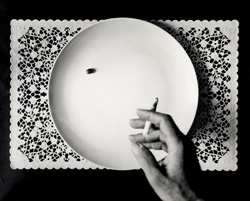Zimmerli Museum exhibit showcases works by Fluxus masters
An art movement-cum-philosophy with international reach and deep Rutgers roots is marking its 50th anniversary with a six-month long celebration at the Jane Voorhees Zimmerli Art Museum on the university’s New Brunswick Campus.
Nurtured by a group of artists who ignored the politics of the establishment, Fluxus – taken from the Latin word meaning “to flow” – was not so much an art movement as an entire world view, at once playful, interactive, irreverent, experimental . . . and boundary-shattering.
“These were basically loose, experimental art works that might include elements of dance, poetry, painting, theater – a mélange – and I knew that Rutgers was a place that I could find them. That’s why I came here in the first place,” says Larry Miller, a Rutgers MFA graduate who both influenced and was influenced by Fluxus.
Titled “at/around/beyond: Fluxus at Rutgers,” the Zimmerli exhibition features more than 60 works from its permanent holding and private collections, including sculptural objects, assemblages, photographs, and performance documentation, among other forms of expression.
“Fluxus was about seeing beauty in everyday objects, tearing down the divisions between life and art,” says Donna Gustafson, Andrew W. Mellon Liaison for Academic Programs and the curator at Zimmerli who organized the anniversary exhibition and attendant events. “Art is not necessarily a grand painting; it is also a small gesture, like making a salad. Why should art and life be separated?”
The exhibition opened Saturday, September 24, and runs through April 1.
Miller was among a small but fervent group of Rutgers faculty members and students during the

“It was a volatile time, and often the arts reflect the volatility of the culture at large,” Miller says, evoking the example of World War I and the rise of Futurism and Dada.
For Sara Seagull, then an art student at Douglass College, the evolution of Fluxus corresponded to the generalized rebellion of students across the nation.
“To my mind, there wasn’t one central event that said ‘Fluxus is here,’ ” recalls Seagull, who has lent some of her own pieces to the show. “Instead, Fluxus was a small secret slice of attitude, and those who were interested shared the secret together.”
According to Miller, that influential circle, both on and off campus, included such figures as Robert Watts and Geoffrey Hendricks; Allan Kaprow, known for his “happenings;” George Brecht; George Segal; Yoko Ono; Roy Lichtenstein; and John Cage, among many others who created what was to become performance art, pop art, and the Fluxus sensibility. And there was the Lithuanian-born artist who came to be known as Mr. Fluxus, George Maciunus, who originally coined the term identifying the phenomenon and who organized the first Fluxus concert in Wiesbaden, Germany, in 1962.
Hendricks, who taught art at Rutgers from 1957 to 2003, invited Maciunus to New Brunswick, where the two staged a highly controversial Flux Mass at the Voorhees Chapel at Douglass in 1970.
A totally secular happening, the mass drew both critical acclaim and public condemnation, as Hendricks recalled in his 2003 book, Critical Mass: Happenings, Fluxus, Performance, Intermedia and Rutgers University, 1958 to 1972.
A key element of Fluxus, the artists agree, was its insistence on turning the conventional upside down – not to mention inside out.
Included in the Zimmerli exhibition, for example, is a pair of Fluxus underwear by Watts, who taught at Rutgers for 35 years; Hendricks’ “Flux Divorce Box,” a wooden box containing a “divorce album” patterned on a wedding album; and Miller’s oversized “Fruit and Vegetable Chess Board,” on which museum visitors are allowed – no, encouraged – to play the game with, say, fresh lemons as pawns.
“The Fluxus artists definitely had a sense of humor, as well as a great love for puzzles and rebuses,” says Donna Gustafson. “They loved making up words, turning language inside out.”
Over the course of the academic year, the Zimmerli will present several rarely seen films, including Watts’ G.W. and Sons with George Segal, and Fluxfilm Anthology, compiled by Maciunas. The museum’s reading room will offer a look at such books as Yoko Ono’s “Grapefruit.”
As part of
the yearlong retrospective, Gustafson and Gerry Beegan, undergraduate director
at the Mason Gross School of the Arts, are leading a Byrne first-year seminar,
“Artists,
Musicians, and Poets in the Museum.”
The seminar introduces students to the movement, which continues to be felt today, and includes visits to the Rutgers exhibition, as well as interactions with visiting artists.
“It’s easy to find the Fluxus footprint all over the place,” Miller says of the movement’s staying power. He and Byrne students will perform at a concert November 2, from 6 to 7 p.m. , as part of the museum’s Art after Hours program. Through a selection of performance scores drawn from the wide group of international artists, it will showcase Fluxus’s appreciation for Zen simplicity in everyday actions, as well as offering a healthy dose of humor and an opportunity for audience participation.